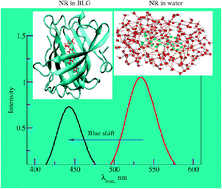Color modeling of protein optical probes†
Abstract
We present a strategy for modeling optical probes within heterogeneous environments of restricted dimension. The method is based on a multiphysics approach comprising sequential structure modeling by means of hybrid Car–Parrinello molecular dynamics and property modeling by means of quantum mechanics/molecular mechanics response theory. For demonstration we address the structural and optical properties of


 Please wait while we load your content...
Please wait while we load your content...